Wood core transformer or lightning protection for computers and televisions
The great Russian poet Tyutchev did not have a computer and a network, otherwise he would not have written: "I love the storm in early May." In recent years, the relevance of lightning protection has become less - optics, wireless technologies, but still.
If a cable comes into your apartment and this cable is not optical, a thunderstorm poses a threat to your equipment.
If you have a TV and it is connected to a common network - cable TV, a collective antenna (suddenly) - to anything outside the apartment, a thunderstorm poses a threat to the TV (even more than a computer).
Before we talk about protection from thunderstorms (from lightning more precisely), consider what we are dealing with.
All interested in the physics and "radio engineering" of lightning: the strength of the current, voltage, duration, spectrum, etc., refer to the fundamental research of Soviet scientists from 1939 .
In short, there are two objects - the cloud and the earth.
The cloud in the process of movement "rubs" on other clouds and on the flow of air, while it exchanges charges with what is rubbed - electrified.
')
In the same way, a synthetic sweater is electrified; if you shoot it through your head, the sparks that pop up are real lightnings of the same nature, only small ones.
So, the cloud has gained charge, and its potential is several million volts. There is a nuance: the potential does not exist by itself and is measured relative to some other object, in this case the earth.
What is earth in terms of electrical engineering? This is a huge conductor, actually a spherical capacitor of enormous capacity, which can receive and release charges in unlimited quantities.
At the same time, due to its size and capacity, no matter how much you pump a charge into the ground, no matter how much you take a charge from the ground, its potential will hardly change.
That is why the potential of the earth is considered to be zero, and other potentials are counted from it.
In the space under the cloud, such a distribution of potentials is formed:
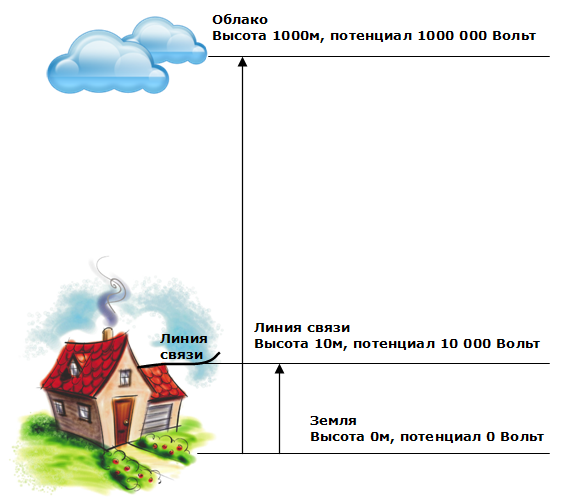
On any wires in open space under a thundercloud, potentials of several thousand volts or more are induced. Despite the horrific numbers, the danger of this situation does not entail:
The voltage is large, but the energy that can be extracted is determined by the capacitance of the wires relative to the earth, and it is scanty.
The situation changes radically, if the cloud "closes" to the ground, then lightning is formed. When this occurs, two phenomena that carry a greater threat to the equipment.
Phenomenon 1: radiation of a powerful electromagnetic wave.
Where does the wave come from? Lightning is actually a conductor, a “pole” with a current, and this current changes dramatically over time. Any change in current generates electromagnetic waves, and lightning, too. The current in a lightning is huge, up to hundreds of thousands of amperes, and the electromagnetic wave is very powerful.
In the "electric" - "magnetic" wave there is an electric and magnetic field (KO).
Where are they headed? The electric field - namely, it interests us - is directed parallel to the lightning.

In the electric field between any two points there is a potential difference - voltage, and this voltage is greater, the greater the distance between the points (well, of course, the larger the field itself).
To put it in Russian, the field of an electromagnetic wave of lightning induces stresses (of several kinds) in all the pieces of iron that are encountered in the path of the wave.
What kind of stress?
Voltage between wires ("antiphase")

As is clearly seen from the figure, the electric field of the wave induces a voltage in parallel wires, and this voltage is greater, the greater the distance between the wires.
This voltage is induced in all wires that are parallel: overhead power lines, telephone noodles, etc. Such a voltage can get, for example, into the power grid and cause a short-term surge in voltage of 220V, or disable the ADSL modem (if for some reason the wire to the modem goes along the street).
However, in domestic conditions, this voltage is not very large due to the small distance between the wires.
It is to compensate for this voltage wires in the twisted pair of the suite, and in the main telephone cables - too. As can be seen from the figure, the stresses of neighboring “curls” destroy each other, giving a total of zero (ideally, of course, in reality, due to many factors, there is still tension on the twisted pair when struck by a lightning).

What does the voltage look like from a computer point of view? So, it was as if he was thrust into the socket of the network card by sharply replacing a small (less than 1 Volt) signal from an Ethernet carrier with a much higher voltage.
So, the threat number 1: antiphase voltage in the communication line during a lightning strike.
Voltage on both wires to ground ("common mode")
Again: the voltage between the conductors in the wave field is greater, the greater the distance between the conductors. But besides wires in the communication line, there are two more conductors: the communication line itself and the earth. The distance between them is much larger than the distance between the wires in the cable, which means that the voltage between the line and the ground is also much greater.

What does the voltage look like from a computer point of view? So, as if connected all the wires in the communication line and connected, say, to the "+" voltage source. The "-" of this source is connected to earth.
“Yes, but after all, our computer is not connected to grounding, and we are not afraid of the potential on the line relative to the earth,” you will say, and submit this picture:

And where does such optimism come from that the computer is not connected to the ground? “Connected to ground” does not mean that a thick grounding bus is coming out of the computer, this means that there is some kind of electrical circuit between the ground and the computer.
Is there such a chain? Often, yes.
In a power supply unit of a conventional system unit, there are no parts between the common wire of the computer (black one) and the “hot” part of the power supply unit (which is plugged in), there are no parts.
And in some power units of monitors and laptops, a capacitor is installed between the ground of the computer and the ground of the hot part of the power supply unit, the purpose is to suppress impulse noise. In fact, through this capacitor, your computer has an excellent grounding for impulse voltages, including those arising from a lightning strike.
“Stop,” you say again. "Is the power supply grounded?"
Yes, because there is zero and a phase in the outlet. Zero 220 Volt household network is connected to earth without fail.
So, assume that your computer is grounded
computer common wire -> monitor common wire -> capacitor in the power supply between the hot and cold part -> elements of the hot part of the power supply unit of the monitor -> zero network -> ground
and the laptop is even shorter
common wire of the notebook circuit -> capacitor in power supply between the hot and cold part -> elements of the hot part of the laptop power supply unit -> zero network -> ground
Is the capacitance of the capacitor enough to pose a threat? Yes. Usually it is several thousand picofarads, and if you charge this capacitor to a voltage of a few kilovolts, its energy is enough to put the computer circuit down.
There are other options for circuits through which a computer can be connected to earth.
If you have a TV tuner and the cable from the cable TV is included, your computer is reliably grounded in a circuit: the common wire of the computer -> outer part of the antenna connector -> braid of the antenna cable -> grounded cable box in the entrance.
If you have a CDMA antenna on a metal mast dug into the ground, your computer is reliably grounded in a circuit: cable braid -> traverse (carrier axis) of the antenna -> mast -> ground.
In fact, a simplified circuit diagram looks like this.

So, threat number 2: common-mode voltage in the line.
Phenomenon 2. Current spreading from lightning and the associated change in earth potential
About threats number 1 and 2 repeatedly wrote. But there is another threat that is usually overlooked, although it is relevant if the computer is truly grounded (TV tuner, antenna - see above) and is particularly relevant for televisions (a little lower on TV separately).
What is earth?The third planet Let's repeat: the main electrical property of the earth is the ability to accept charges indefinitely.
And what else can charges take? Any piece of iron, any conductor, any piece of an electrical circuit, acting simply as a conductor. Such a “pseudo-earth,” of course, takes much less charges, simply by virtue of its size, capacity, if you like, but still accepts.
So, struck by lightning. In a lightning current flows, charges are transferred, all sorts of electrons there.
And where are they transferred? In the ground, where the lightning struck.

A current flows in the ground, “spreading” around the place of a lightning strike. The potential of the earth around the impact site ceases to be zero, and if your grounding is somewhere near the lightning strike, then its potential at the moment of impact increases dramatically, and grounding charges from the ground to your computer or TV.
And where do they go next? For these charges, the role of the "earth" is performed by a computer or TV circuit, the charges spread in the circuit, and currents flow through the electronic components of the circuit, which can lead to the failure of these nodes.

So, when a lightning strikes a computer / TV, four damaging factors act at once (hazard assessment is subjective and based on repair experience):

Protection
Abstraction: you can protect yourself from the stream in two ways: close the stream or divert it to another channel.
Removal of energy flow
The simplest principle of lightning protection: to close or dump excess energy into the earth, important for common-mode and anti-phase voltages.
The conditional scheme is simple:
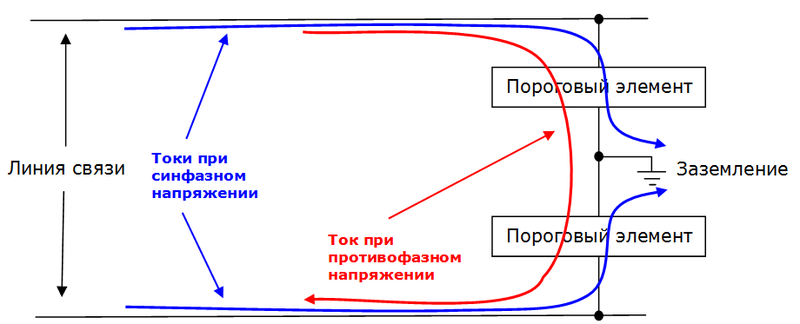
When the voltage is exceeded ("wire-to-wire" or "wire-to-ground"), the threshold element opens and closes the circuit.
One of the best options for threshold elements is gas-discharge devices, the simplest option is ordinary neon.
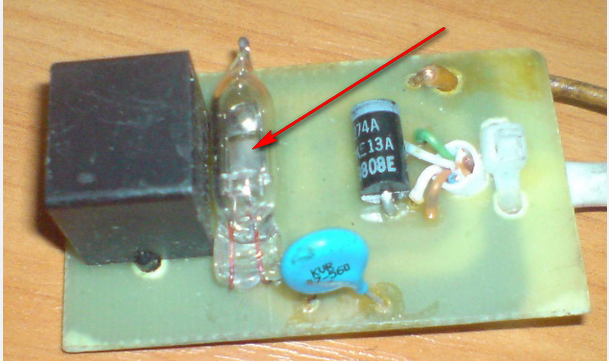

Neonka is not the best discharger for such purposes: high internal resistance, low power dissipation, and indeed it is not for that.
There are specialized surge arresters specifically for protecting lines:

and lightning protection with such a spark gap

Variants of such lightning protection schemes basically boil down to how to put one expensive arrester on several lines and how to add additional protective elements (varistors, spark gaps).
On the Internet there is a mass and devices on sale, and schemes forthe implementation itself .
Does it make sense to apply such protection? Of course there is, and there were a lot of situations when they were rescued. The price of the issue is a few dollars.
But pay attention to this:
1. All protections do not apply to televisions and generally grounded appliances (see above).
2. All such protections operate with the full power of voltages induced in the line by lightning, dropping / closing part of it.
There is a way to reduce the power of voltages induced in the line by lightning.
Galvanic isolation
In electrical engineering and radio engineering there is a concept of “galvanic isolation” - when what is needed is transmitted, there is no electrical connection between the transmitting and receiving parts.
The simplest example is a transformer. How does he work? One winding of the magnetic reversal of the magnetic core, due to this magnetization reversal, a voltage arises in the second winding, something like this:
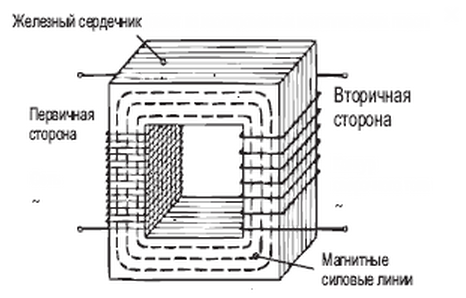
The main thing that interests us in this device:
- primary and secondary windings are not interconnected. No Common-mode voltage, in principle, through the transformer will not pass
- you can connect the primary winding even to the megawatt power station - in the secondary winding you will not get more power than the core can pass through.
If we install a transformer on all incoming pairs of ethernet, and on the TV - on the antenna input, we will solve a lot of problems.
Firstly, we will unleash the iron from the ground and eliminate the most dangerous problem - the leakage of currents from lightning into our device.
Let me emphasize that it is relevant mainly for TVs, there have been many burned out after a thunderstorm, and not BP, but internal nodes with a high degree of integration - processors, signal processing chips, etc. - failed.
Secondly, the anti-phase interference, of course, will get to the input of the device, but its power will be limited by the transformer and will not bring harm. In addition, now it can be easily and reliably cut off by lightning protection.
Thirdly, the common-mode noise to us will not fall at all.
Beauty? Of course. Just do not forget that in addition to the protective functions, the transformer must still skip the signal without any problems, and then the nuances begin.
At the entrance of the network card, there are mandatory transformers, here are the first schemes found in Google:
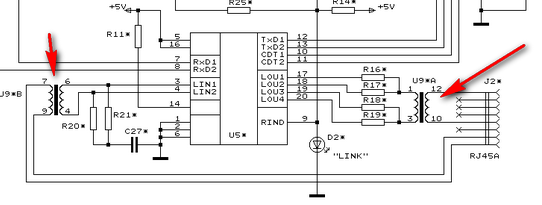
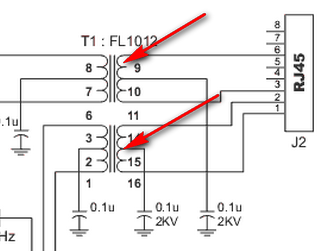
But practice shows that in reality there is not much use from them, and the network cards are burning, and everything else. Perhaps this is due to design features, or with the breakdown of the insulation of very thin enamelled conductors with which they are wound.
It’s hardly realistic to make independently the same,but without wings, but an improved transformer with a magnetic core - for Ethernet 100base-t frequencies and television frequencies (hundreds of megahertz), the design and construction of the transformer are complex, plus a special high-frequency magnetic circuit material is needed.
But everything can be solved much easier.
Wooden core transformer
We take a piece of twisted pair, half a meter - meter, uncritically.
Important! Twisted pair should not be damaged, unraveled, broken pitch of coils and so on. - Carefully remove from the cable, do not pull the wire!
We wind on any non-metallic mandrel - you can like this:

or so

Seriously, we wind non-conductive nonmetallic onto anything, but make it comfortable. How to wind, the number of turns and so on. - Uncritical.
We leave the ends to 5 cm, fix the winding - again with something non-conductive, unwind the ends and weave it differently: we twist together the ends of the same color.
It turns out this:
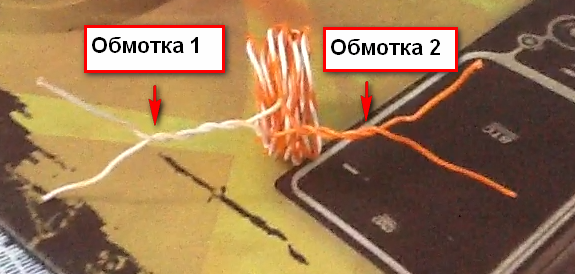
That is, each wire is a separate winding.
This is a transformer, but operating on a different principle: a transformer on a long line.
The long line in this case is a twisted pair piece. With an active Ethernet network, an electromagnetic wave is excited in it, and its energy is concentrated inside the pair (that is why it is unimportant to reel on). The energy field of this electromagnetic wave provides a signal from one wire to another.
How to use such a transformer to protect against lightning?
Make two such transformers. They need to be inserted into the gap of two pairs in any way - you can simply cut the cable neatly, cut the necessary pairs and plug these transformers into the gap. Polarity is uncritical.
Immediately answer questions.
This is not a joke, the design is tested and used. I do not turn off in a thunderstorm at all, there were no problems, before that I burned a couple of network cards and the motherboard.
On the Internet there are similar options for transformers, but wound on a ferrite ring.
I am against this: the ring is not involved in signal transmission, but the ferrite is a conductor, a bad one, but a conductor. Winding on the ring, unnecessary parasitic capacitances are introduced and it becomes possible to breakdown on the core when struck by lightning.
But on the ring, of course, the design looks more beautiful. A matter of taste.
On the gigabit network is not checked.
Losses such a design does not contribute to the length of a twisted pair in a transformer from 0.5 meters.
Measurements by the instrument (HF-Voltmeter improvised) do not show a drop in the signal level.
Link up to 100 meters works the same way as it worked - 0% loss, ping time has not changed.
In general, from the point of view of network operation, the presence of two such transformers in the breaks of the incoming power cable is not detected.
Other lightning protection I do not use.
TV protection
Here the main task is to get rid of the earth, which “comes” by braiding the antenna cable. The principle is the same: include such a transformer in the cable break, but there may be some nuances.
The characteristic impedance of the twisted pair and the antenna cable is different, plus the twisted pair is symmetrical, but the antenna cable is not. Therefore, the reception level of some analog channels may fall (or may not fall visually), may appear on some — again, analog — channels of ghosting. You can experiment with the length of a piece of twisted pair in a transformer, you can try to make a similar design of the antenna cable.
I'm on a thunderstorm to the TV doing such a thing. A little snow appears on channel 1 of 70.
And in conclusion an important point.
Nothing will save you from direct lightning striking a cable. Moreover, in such a situation, you will not be concerned about the safety of the network board, and so that the apartment does not burn out.
Be prudent, do not use long copper lines going down the street and coming into your apartment.
If a cable comes into your apartment and this cable is not optical, a thunderstorm poses a threat to your equipment.
If you have a TV and it is connected to a common network - cable TV, a collective antenna (suddenly) - to anything outside the apartment, a thunderstorm poses a threat to the TV (even more than a computer).
Before we talk about protection from thunderstorms (from lightning more precisely), consider what we are dealing with.
All interested in the physics and "radio engineering" of lightning: the strength of the current, voltage, duration, spectrum, etc., refer to the fundamental research of Soviet scientists from 1939 .
In short, there are two objects - the cloud and the earth.
The cloud in the process of movement "rubs" on other clouds and on the flow of air, while it exchanges charges with what is rubbed - electrified.
')
In the same way, a synthetic sweater is electrified; if you shoot it through your head, the sparks that pop up are real lightnings of the same nature, only small ones.
So, the cloud has gained charge, and its potential is several million volts. There is a nuance: the potential does not exist by itself and is measured relative to some other object, in this case the earth.
What is earth in terms of electrical engineering? This is a huge conductor, actually a spherical capacitor of enormous capacity, which can receive and release charges in unlimited quantities.
At the same time, due to its size and capacity, no matter how much you pump a charge into the ground, no matter how much you take a charge from the ground, its potential will hardly change.
That is why the potential of the earth is considered to be zero, and other potentials are counted from it.
In the space under the cloud, such a distribution of potentials is formed:

On any wires in open space under a thundercloud, potentials of several thousand volts or more are induced. Despite the horrific numbers, the danger of this situation does not entail:
The voltage is large, but the energy that can be extracted is determined by the capacitance of the wires relative to the earth, and it is scanty.
The situation changes radically, if the cloud "closes" to the ground, then lightning is formed. When this occurs, two phenomena that carry a greater threat to the equipment.
Phenomenon 1: radiation of a powerful electromagnetic wave.
Where does the wave come from? Lightning is actually a conductor, a “pole” with a current, and this current changes dramatically over time. Any change in current generates electromagnetic waves, and lightning, too. The current in a lightning is huge, up to hundreds of thousands of amperes, and the electromagnetic wave is very powerful.
In the "electric" - "magnetic" wave there is an electric and magnetic field (KO).
Where are they headed? The electric field - namely, it interests us - is directed parallel to the lightning.

In the electric field between any two points there is a potential difference - voltage, and this voltage is greater, the greater the distance between the points (well, of course, the larger the field itself).
To put it in Russian, the field of an electromagnetic wave of lightning induces stresses (of several kinds) in all the pieces of iron that are encountered in the path of the wave.
What kind of stress?
Voltage between wires ("antiphase")

As is clearly seen from the figure, the electric field of the wave induces a voltage in parallel wires, and this voltage is greater, the greater the distance between the wires.
This voltage is induced in all wires that are parallel: overhead power lines, telephone noodles, etc. Such a voltage can get, for example, into the power grid and cause a short-term surge in voltage of 220V, or disable the ADSL modem (if for some reason the wire to the modem goes along the street).
However, in domestic conditions, this voltage is not very large due to the small distance between the wires.
It is to compensate for this voltage wires in the twisted pair of the suite, and in the main telephone cables - too. As can be seen from the figure, the stresses of neighboring “curls” destroy each other, giving a total of zero (ideally, of course, in reality, due to many factors, there is still tension on the twisted pair when struck by a lightning).

What does the voltage look like from a computer point of view? So, it was as if he was thrust into the socket of the network card by sharply replacing a small (less than 1 Volt) signal from an Ethernet carrier with a much higher voltage.
So, the threat number 1: antiphase voltage in the communication line during a lightning strike.
Voltage on both wires to ground ("common mode")
Again: the voltage between the conductors in the wave field is greater, the greater the distance between the conductors. But besides wires in the communication line, there are two more conductors: the communication line itself and the earth. The distance between them is much larger than the distance between the wires in the cable, which means that the voltage between the line and the ground is also much greater.

What does the voltage look like from a computer point of view? So, as if connected all the wires in the communication line and connected, say, to the "+" voltage source. The "-" of this source is connected to earth.
“Yes, but after all, our computer is not connected to grounding, and we are not afraid of the potential on the line relative to the earth,” you will say, and submit this picture:

And where does such optimism come from that the computer is not connected to the ground? “Connected to ground” does not mean that a thick grounding bus is coming out of the computer, this means that there is some kind of electrical circuit between the ground and the computer.
Is there such a chain? Often, yes.
In a power supply unit of a conventional system unit, there are no parts between the common wire of the computer (black one) and the “hot” part of the power supply unit (which is plugged in), there are no parts.
And in some power units of monitors and laptops, a capacitor is installed between the ground of the computer and the ground of the hot part of the power supply unit, the purpose is to suppress impulse noise. In fact, through this capacitor, your computer has an excellent grounding for impulse voltages, including those arising from a lightning strike.
“Stop,” you say again. "Is the power supply grounded?"
Yes, because there is zero and a phase in the outlet. Zero 220 Volt household network is connected to earth without fail.
So, assume that your computer is grounded
computer common wire -> monitor common wire -> capacitor in the power supply between the hot and cold part -> elements of the hot part of the power supply unit of the monitor -> zero network -> ground
and the laptop is even shorter
common wire of the notebook circuit -> capacitor in power supply between the hot and cold part -> elements of the hot part of the laptop power supply unit -> zero network -> ground
Is the capacitance of the capacitor enough to pose a threat? Yes. Usually it is several thousand picofarads, and if you charge this capacitor to a voltage of a few kilovolts, its energy is enough to put the computer circuit down.
There are other options for circuits through which a computer can be connected to earth.
If you have a TV tuner and the cable from the cable TV is included, your computer is reliably grounded in a circuit: the common wire of the computer -> outer part of the antenna connector -> braid of the antenna cable -> grounded cable box in the entrance.
If you have a CDMA antenna on a metal mast dug into the ground, your computer is reliably grounded in a circuit: cable braid -> traverse (carrier axis) of the antenna -> mast -> ground.
In fact, a simplified circuit diagram looks like this.

So, threat number 2: common-mode voltage in the line.
Phenomenon 2. Current spreading from lightning and the associated change in earth potential
About threats number 1 and 2 repeatedly wrote. But there is another threat that is usually overlooked, although it is relevant if the computer is truly grounded (TV tuner, antenna - see above) and is particularly relevant for televisions (a little lower on TV separately).
What is earth?
And what else can charges take? Any piece of iron, any conductor, any piece of an electrical circuit, acting simply as a conductor. Such a “pseudo-earth,” of course, takes much less charges, simply by virtue of its size, capacity, if you like, but still accepts.
So, struck by lightning. In a lightning current flows, charges are transferred, all sorts of electrons there.
And where are they transferred? In the ground, where the lightning struck.

A current flows in the ground, “spreading” around the place of a lightning strike. The potential of the earth around the impact site ceases to be zero, and if your grounding is somewhere near the lightning strike, then its potential at the moment of impact increases dramatically, and grounding charges from the ground to your computer or TV.
And where do they go next? For these charges, the role of the "earth" is performed by a computer or TV circuit, the charges spread in the circuit, and currents flow through the electronic components of the circuit, which can lead to the failure of these nodes.

So, when a lightning strikes a computer / TV, four damaging factors act at once (hazard assessment is subjective and based on repair experience):

Protection
Abstraction: you can protect yourself from the stream in two ways: close the stream or divert it to another channel.
Removal of energy flow
The simplest principle of lightning protection: to close or dump excess energy into the earth, important for common-mode and anti-phase voltages.
The conditional scheme is simple:

When the voltage is exceeded ("wire-to-wire" or "wire-to-ground"), the threshold element opens and closes the circuit.
One of the best options for threshold elements is gas-discharge devices, the simplest option is ordinary neon.


Neonka is not the best discharger for such purposes: high internal resistance, low power dissipation, and indeed it is not for that.
There are specialized surge arresters specifically for protecting lines:

and lightning protection with such a spark gap

Variants of such lightning protection schemes basically boil down to how to put one expensive arrester on several lines and how to add additional protective elements (varistors, spark gaps).
On the Internet there is a mass and devices on sale, and schemes for
Does it make sense to apply such protection? Of course there is, and there were a lot of situations when they were rescued. The price of the issue is a few dollars.
But pay attention to this:
1. All protections do not apply to televisions and generally grounded appliances (see above).
2. All such protections operate with the full power of voltages induced in the line by lightning, dropping / closing part of it.
There is a way to reduce the power of voltages induced in the line by lightning.
Galvanic isolation
In electrical engineering and radio engineering there is a concept of “galvanic isolation” - when what is needed is transmitted, there is no electrical connection between the transmitting and receiving parts.
The simplest example is a transformer. How does he work? One winding of the magnetic reversal of the magnetic core, due to this magnetization reversal, a voltage arises in the second winding, something like this:

The main thing that interests us in this device:
- primary and secondary windings are not interconnected. No Common-mode voltage, in principle, through the transformer will not pass
- you can connect the primary winding even to the megawatt power station - in the secondary winding you will not get more power than the core can pass through.
If we install a transformer on all incoming pairs of ethernet, and on the TV - on the antenna input, we will solve a lot of problems.
Firstly, we will unleash the iron from the ground and eliminate the most dangerous problem - the leakage of currents from lightning into our device.
Let me emphasize that it is relevant mainly for TVs, there have been many burned out after a thunderstorm, and not BP, but internal nodes with a high degree of integration - processors, signal processing chips, etc. - failed.
Secondly, the anti-phase interference, of course, will get to the input of the device, but its power will be limited by the transformer and will not bring harm. In addition, now it can be easily and reliably cut off by lightning protection.
Thirdly, the common-mode noise to us will not fall at all.
Beauty? Of course. Just do not forget that in addition to the protective functions, the transformer must still skip the signal without any problems, and then the nuances begin.
At the entrance of the network card, there are mandatory transformers, here are the first schemes found in Google:


But practice shows that in reality there is not much use from them, and the network cards are burning, and everything else. Perhaps this is due to design features, or with the breakdown of the insulation of very thin enamelled conductors with which they are wound.
It’s hardly realistic to make independently the same,
But everything can be solved much easier.
Wooden core transformer
We take a piece of twisted pair, half a meter - meter, uncritically.
Important! Twisted pair should not be damaged, unraveled, broken pitch of coils and so on. - Carefully remove from the cable, do not pull the wire!
We wind on any non-metallic mandrel - you can like this:

or so

Seriously, we wind non-conductive nonmetallic onto anything, but make it comfortable. How to wind, the number of turns and so on. - Uncritical.
We leave the ends to 5 cm, fix the winding - again with something non-conductive, unwind the ends and weave it differently: we twist together the ends of the same color.
It turns out this:

That is, each wire is a separate winding.
This is a transformer, but operating on a different principle: a transformer on a long line.
The long line in this case is a twisted pair piece. With an active Ethernet network, an electromagnetic wave is excited in it, and its energy is concentrated inside the pair (that is why it is unimportant to reel on). The energy field of this electromagnetic wave provides a signal from one wire to another.
How to use such a transformer to protect against lightning?
Make two such transformers. They need to be inserted into the gap of two pairs in any way - you can simply cut the cable neatly, cut the necessary pairs and plug these transformers into the gap. Polarity is uncritical.
Immediately answer questions.
This is not a joke, the design is tested and used. I do not turn off in a thunderstorm at all, there were no problems, before that I burned a couple of network cards and the motherboard.
On the Internet there are similar options for transformers, but wound on a ferrite ring.
I am against this: the ring is not involved in signal transmission, but the ferrite is a conductor, a bad one, but a conductor. Winding on the ring, unnecessary parasitic capacitances are introduced and it becomes possible to breakdown on the core when struck by lightning.
But on the ring, of course, the design looks more beautiful. A matter of taste.
On the gigabit network is not checked.
Losses such a design does not contribute to the length of a twisted pair in a transformer from 0.5 meters.
Measurements by the instrument (HF-Voltmeter improvised) do not show a drop in the signal level.
Link up to 100 meters works the same way as it worked - 0% loss, ping time has not changed.
In general, from the point of view of network operation, the presence of two such transformers in the breaks of the incoming power cable is not detected.
Other lightning protection I do not use.
TV protection
Here the main task is to get rid of the earth, which “comes” by braiding the antenna cable. The principle is the same: include such a transformer in the cable break, but there may be some nuances.
The characteristic impedance of the twisted pair and the antenna cable is different, plus the twisted pair is symmetrical, but the antenna cable is not. Therefore, the reception level of some analog channels may fall (or may not fall visually), may appear on some — again, analog — channels of ghosting. You can experiment with the length of a piece of twisted pair in a transformer, you can try to make a similar design of the antenna cable.
I'm on a thunderstorm to the TV doing such a thing. A little snow appears on channel 1 of 70.
And in conclusion an important point.
Nothing will save you from direct lightning striking a cable. Moreover, in such a situation, you will not be concerned about the safety of the network board, and so that the apartment does not burn out.
Be prudent, do not use long copper lines going down the street and coming into your apartment.
Source: https://habr.com/ru/post/143061/
All Articles